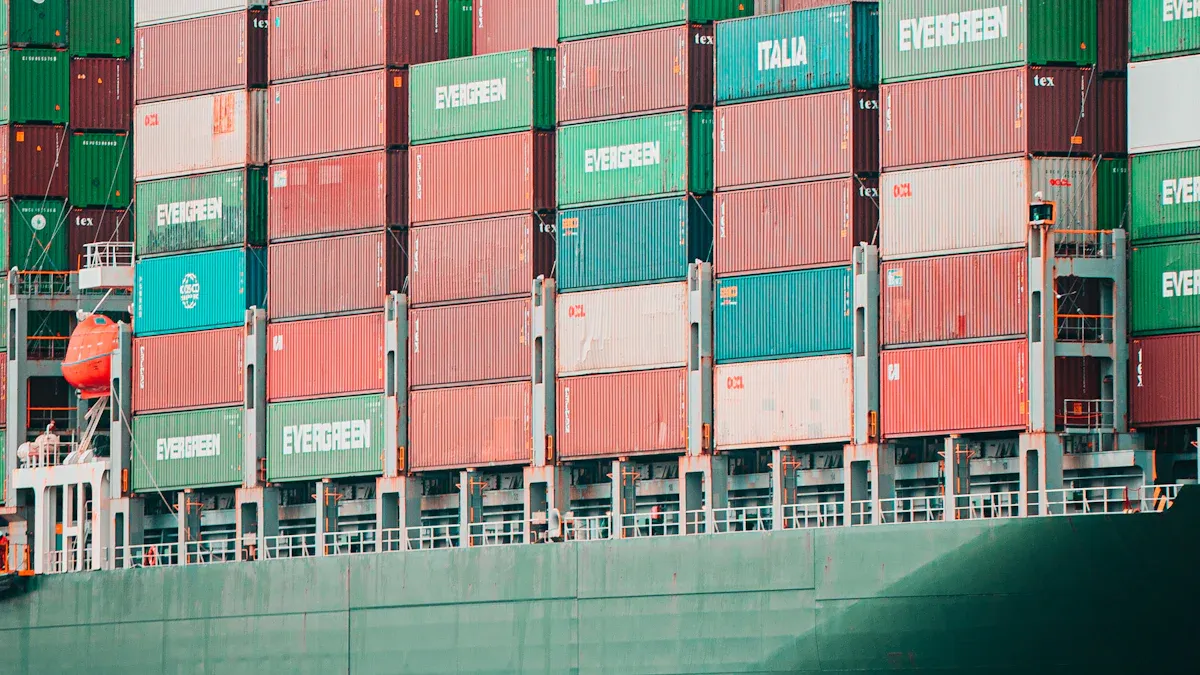How Supply Chain Management Operates and Why It Matters in 2025

Supply chain management is key to global trade. It helps goods, information, and money move smoothly. Today, there are challenges like changing oil prices and trade rules. Complex laws also make things harder. Businesses need smart ideas to stay ahead. Sustainability is important, so companies try greener methods. In 2025, supply chain management will matter even more. Companies will use it to handle problems, save money, and keep customers happy. By learning this skill, you can stay ahead in a changing world market.
Key Takeaways
Supply chain management is key for easy global trade. It helps businesses move products, data, and money quickly.
Smart tools like AI and blockchain make supply chains better. These tools predict issues and help make good choices.
Planning and forecasting are very important. They stop extra stock and help meet customer needs well.
Strong supplier relationships improve risk handling. This gives better service and happier customers.
Being eco-friendly is now important. Green practices help companies look good and protect Earth.
What Is Supply Chain Management and Why It Matters in 2025
Definition and Purpose of Supply Chain Management
Supply chain management helps move goods, money, and information smoothly. It includes planning, making, and delivering products to customers. The main goal is to meet needs while saving time and money. Sharing real-time data helps avoid mistakes and make better choices. Each step in the supply chain adds value, from raw materials to stores. By connecting these steps, businesses can quickly adjust to changes and stay competitive.
The Role of Supply Chain Management in Business Success
Supply chain management is important for a company’s success. It makes work easier by cutting waste and improving processes. Companies using smart supply chain methods save money and keep customers happy. For example, Renovit, a Certified B Corp, used digital tools to track orders and manage suppliers. This reduced risks and made work faster. Businesses also plan for problems by using better tools and having more suppliers. By using new technology, companies can stay strong and compete in a fast-changing world.
Key Trends Shaping Supply Chain Management in 2025
In 2025, supply chain management will change in big ways. Companies will use smart tools to predict problems and work better with others. Fewer workers in warehouses and transport will lead to more automation. People will want faster delivery and fairer sourcing of goods. Cybersecurity will be very important as threats grow. Tools like AI and blockchain will make supply chains clearer and faster. Real-time updates will help businesses save money and adjust to changes. These trends show how supply chains will mix saving costs with new ideas.
Trend/Strategy | Description |
|---|---|
Fewer workers in transport and warehouses need solutions. | |
Predictive Technologies | New tools help predict problems and improve teamwork. |
Companies are finding safer ways to get and make products. | |
Integration of Advanced Technologies | AI and blockchain will make supply chains faster and clearer. |
Key Components of Supply Chain Management

Planning and Forecasting in Supply Chain Management
Planning and forecasting are very important in supply chains. You need to guess demand to have products ready on time. This means looking at past data, trends, and customer habits. Doing this helps avoid too much or too little stock. For example, Sunsweet Growers used better planning tools to save money.
Many companies improve their sales and operations planning (S&OP). This helps match production with what people want. A luxury fashion brand made its supply chain better to please customers. An AgriTech company changed its S&OP to meet market needs. These examples show how good planning saves money and manages inventory well.
Case Study Title | Description |
|---|---|
S&OP Excellence Initiative for Pharmaceutical Firm | Better forecasts and lower inventory costs. |
Luxury Brand Global Supply Chain Alignment | Improved demand guessing and happier customers. |
Sunsweet Growers | Saved money by using smarter planning tools. |
Sourcing and Procurement Processes
Sourcing and procurement find good suppliers and handle buying. You can save money by finding deals and using fewer suppliers. This also helps lower risks and follow company rules. Many companies try to cut pollution and add diversity to their suppliers.
Looking at buying data can show new chances for business. You can improve payment plans and cash flow by studying trends. Managing risks is also very important. Finding and fixing supplier risks keeps things running smoothly. These steps make sourcing and procurement key parts of supply chains.
Improvement Area | Description |
|---|---|
Finding ways to save money and track results. | |
Risk management | Fixing supplier or market risks to avoid problems. |
Corporate responsibility | Supporting fairness, diversity, and cutting pollution in suppliers. |
Manufacturing and Production Operations
Manufacturing turns raw materials into finished products. This needs to be done carefully and efficiently. Production must match demand to avoid wasting resources. New tools like automation and IoT help make work faster and easier.
Good production also needs smart inventory tracking. Watching stock levels stops shortages and keeps goods flowing. Companies use live data to check production and change plans if needed. This boosts output and cuts costs. Manufacturing links sourcing to delivery in the supply chain.
Logistics, Distribution, and Warehousing Solutions by JUSDA
Good logistics, distribution, and warehousing are very important. They help move goods from factories to customers without problems. JUSDA uses smart tools to make these steps better. With over 155 service points and 2.5 million square meters of warehouse space, JUSDA supports businesses worldwide.
JUSDA's warehouses use advanced technology to manage inventory. Tools like JusLink and eVMI track stock in real time. This helps avoid running out of products. JUSDA also offers services like packing, labeling, and picking. These services make work faster and reduce mistakes. For example, JUSDA Vietnam has seven warehouses with 110,000 square meters of space. These warehouses serve industries like cars and electronics, keeping inventory organized.
Transport and logistics are just as important. JUSDA combines air, land, sea, and rail transport for smooth deliveries. Their global system ensures goods arrive on time, even across borders. Using smart systems, JUSDA reduces delays and improves supply chain work.
Tip: Tracking inventory in real time saves money and keeps customers happy with on-time deliveries.
Customer Service and Returns Management
Customer service and returns are key to happy customers. Good systems process returns quickly and correctly. This builds trust and makes customers come back.
Some companies improved customer service with better supply chain methods. SpaceManager Closets used smart scheduling to work faster. Boca Terry improved delivery times by tracking overseas shipping better. Killer Merch made customer communication easier, speeding up orders. These examples show how supply chains can improve customer experiences.
Returns also get better with good inventory tracking. Watching returned items in real time helps restock or fix them faster. This cuts waste and makes work smoother. JUSDA's JusLink tool helps manage returns with live updates.
Note: A good returns system saves money and makes your brand stronger.
How Supply Chain Management Works
Understanding the Flow of Goods, Information, and Finances
Supply chain management links goods, information, and money between businesses. It works like a team where suppliers, factories, and stores help deliver products. Each step adds value, from getting materials to sending finished items.
A supply chain is a system where suppliers, factories, distributors, and stores work together. They plan and manage the movement of materials and products to customers.
Math models help businesses improve how things flow. These models use numbers to manage stock, predict needs, and plan deliveries. By studying data, companies can save money and make smarter choices.
Processes and Technologies Driving Supply Chain Management
Modern supply chains use smart tools and methods to work better. Joining systems together makes everything run smoothly. For example, blockchain tools like OpenSC and TradeLens track products and shipping details. These tools check if goods are made responsibly and make deliveries faster.
Cloud systems are also very helpful. Avaya switched to one cloud system, which made inventory faster by 200% and cut stock costs by 94%. These tools show how joining systems can improve making and delivering products.
JUSDA's JusLink Platform and Its Role in Supply Chain Efficiency
JUSDA's JusLink platform makes supply chains even better. It uses IoT, cloud systems, and big data to give live updates. This helps predict needs and manage stock better. A study showed JusLink improved predictions by 78%, making work much smoother.
The platform helps industries like cars and electronics with smart tools for planning and restocking. JusLink gives a clear view of goods and services, helping businesses make better plans and avoid risks.
Tip: Real-time tools like JusLink can improve your supply chain and keep you ahead in a fast-changing world.
Why Supply Chain Management Is Critical for Businesses
Enhancing Efficiency and Reducing Costs
Supply chain management helps businesses save money and work better. By improving processes, companies waste less and get more done. For example, using smart tools can make predictions more accurate. Sunsweet Growers made their forecasts 15-20% better. This cut overtime in factories from 25% to 8%. They also reduced spoiled goods by 30%.
Good supply chains also lower business costs. Companies with strong supply chains spend 15% less than others. Advanced tools can cut storage costs by up to 90%. These savings let businesses grow by investing in other areas.
Tip: Use live data and smart tools to avoid extra stock and waste.
Improving Customer Satisfaction and Loyalty
A good supply chain makes sure customers get what they need on time. This builds trust and keeps them coming back. Working well with supply chain partners improves service, product availability, and delivery. These things make customers happier.
When supply chains run smoothly, customers notice. They like fast deliveries and reliable products. Happy customers stay loyal and help your brand grow. By focusing on teamwork and efficiency, you can give customers a better experience.
Note: Satisfied customers are more likely to tell others about your business, helping you reach more people.
Supporting Business Growth and Competitiveness
Supply chain management helps businesses grow by moving products quickly. It reduces delays and saves money, making companies more profitable.
A strong supply chain also helps businesses adapt to changes. Companies can meet customer needs faster and handle market shifts. Good supplier relationships and risk planning make businesses stronger. By improving operations and the flow of goods, companies stay ahead in a changing market.
Tip: Use supply chain management to stay strong and compete in your industry.
Challenges and Future Trends in Supply Chain Management
Modern Challenges: Globalization, Sustainability, and Disruptions
Supply chains today face many problems in a connected world. Political issues and conflicts hurt trade and cause delays. Companies must act responsibly to protect the planet and their reputation. Changing rules and fewer skilled workers make managing supply chains harder.
Challenge | Description |
|---|---|
Globalization Disputes | Political problems affect trade and create delays. |
Sustainability Efforts | Responsible actions lower risks and help the environment. |
New rules and worker shortages make supply chains harder to manage. |
To solve these problems, companies can use smart buying plans. They can work with more suppliers and keep extra stock of key items. These actions make supply chains stronger and less risky, even during tough times.
Tip: Focus on being flexible and eco-friendly to handle future challenges better.
Future Trends: AI, Automation, and Cloud Computing in Supply Chains
Technology is changing how supply chains work. AI tools like Intelligent Virtual Assistants (IVAs) do simple tasks, find problems early, and give helpful advice. This makes work faster and easier. Cloud systems work with AI to use tools like machine learning. These tools help businesses make better choices and save money.
Automation is also improving logistics. Robots handle tasks like tracking stock and organizing shipments quickly. Many companies already use robots, and more plan to start soon. Blockchain tools like TradeLens and OpenSC make supply chains clearer by showing where products come from and how they move.
Note: Using AI, robots, and cloud systems helps your business stay ahead and ready for the future.
JUSDA's Vision for the Future of Supply Chain Management
JUSDA sees a future with smarter and greener supply chains. Tools like JusLink use IoT, cloud systems, and big data to give live updates and predict needs. This helps businesses plan better and avoid risks.
Blockchain tools improve honesty and responsible sourcing. For example:
OpenSC lets people check a product’s history with QR codes to ensure it was made responsibly.
TradeLens shares shipping details and tracks nearly half of global cargo.
JUSDA also tackles new risks like political problems, money issues, and climate change. By using digital tools, JUSDA helps businesses handle challenges and stay strong.
Tip: Working with JUSDA keeps your supply chain strong and ready for the future.

JUSDA Solutions
To provide you with professional solutions and quotations.
In 2025, supply chain management will be very important. It helps businesses work better, save money, and stay competitive. Using tools like AI, IoT, and blockchain makes decisions smarter. JUSDA’s JusLink tool improves planning and tracks goods easily. It even made forecasting 78% more accurate. Working closely with suppliers builds stronger systems and supports green goals. Companies like Apple and Unilever show how eco-friendly actions help the planet. By using these ideas, businesses can prepare for changes and succeed in a fast-moving market.
See Also
Transforming Supply Chain Management Through Cloud Solutions
The Future of Logistics: AI in Supply Chains
Mastering Supply Chain Strategies for Manufacturing Success 2024
The Importance of Sustainable Supply Chains for Businesses
Industries Transformed by Cloud-Based Supply Chain Solutions
